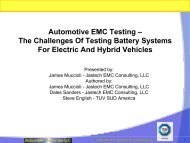EMC Design and Suppression for DC Motors in - Jastech EMC ...
EMC Design and Suppression for DC Motors in - Jastech EMC ...
EMC Design and Suppression for DC Motors in - Jastech EMC ...
You also want an ePaper? Increase the reach of your titles
YUMPU automatically turns print PDFs into web optimized ePapers that Google loves.
The Southeastern Michigan IEEE <strong>EMC</strong> Society<br />
“<strong>EMC</strong> DESIGN AND SUPPRESSION FOR<br />
<strong>DC</strong> MOTORS IN MILITARY AND<br />
AUTOMOTIVE VEHICLES”<br />
Presented by: James Muccioli<br />
<strong>Jastech</strong> <strong>EMC</strong> Consult<strong>in</strong>g, LLC<br />
Authors:<br />
James Muccioli & Dale S<strong>and</strong>ers<br />
<strong>Jastech</strong> <strong>EMC</strong> Consult<strong>in</strong>g, LLC<br />
1
Abstract<br />
As the next generation of vehicle technology emerges, the amount of electronic<br />
technology <strong>and</strong> electronic features <strong>in</strong>crease the complexity of vehicle system<br />
<strong>in</strong>tegration. Vehicle power supplies are no longer simple battery supplied 12V or<br />
24V systems with isolated electronic modules.<br />
Next generation vehicles have more <strong>DC</strong> motors used <strong>in</strong> new applications. The<br />
ability to suppress EMI cost effectively requires more than just throw<strong>in</strong>g a filter on<br />
the motor. To effectively meet requirements <strong>and</strong> cost criteria a system eng<strong>in</strong>eer<strong>in</strong>g<br />
approach is required from concept to production.<br />
2
1. Develop<strong>in</strong>g an <strong>EMC</strong> Test Plan<br />
a. Requirements<br />
b. Variables <strong>in</strong> <strong>EMC</strong> Test set-up<br />
c. Goals <strong>for</strong> each stage of test<strong>in</strong>g<br />
2. Motor design <strong>for</strong> <strong>EMC</strong><br />
a. Hous<strong>in</strong>g<br />
b. End cap<br />
c. Lead <strong>and</strong> term<strong>in</strong>al location<br />
d. Bear<strong>in</strong>gs <strong>and</strong> bush<strong>in</strong>gs<br />
e. Brush design<br />
3
Systems Eng<strong>in</strong>eer<strong>in</strong>g Approach to <strong>EMC</strong><br />
Description<br />
Be<strong>for</strong>e discuss<strong>in</strong>g the process <strong>for</strong> develop<strong>in</strong>g good requirements, some important def<strong>in</strong>itions must be<br />
established:<br />
System: a set of components act<strong>in</strong>g together to achieve a set of common objectives via the<br />
accomplishment of a set of tasks.<br />
System Behavior: a sequence of functions or tasks, with <strong>in</strong>puts <strong>and</strong> outputs, that must be per<strong>for</strong>med<br />
to achieve a specific objective.<br />
Requirement: m<strong>and</strong>ates that someth<strong>in</strong>g must be accomplished, trans<strong>for</strong>med, produced, or provided.<br />
The attributes of a good requirement are that it is unambiguous, underst<strong>and</strong>able, traceable, correct,<br />
concise, unique <strong>and</strong> verifiable.<br />
Traceable: <strong>in</strong> reference to requirements; a requirement is said to be traceable if one can identify its<br />
source. The source may be a higher level requirement or a source document def<strong>in</strong><strong>in</strong>g its existence. An<br />
example would be if a component level requirement (weight, reliability) is traceable back to a vehicle<br />
level requirement.<br />
Operational Concept: an operational concept is a shared vision from the perspective of the users <strong>and</strong><br />
development participants of how the system will be developed, produced, deployed, tra<strong>in</strong>ed, operated,<br />
ma<strong>in</strong>ta<strong>in</strong>ed, ref<strong>in</strong>ed <strong>and</strong> retired to meet the operational needs <strong>and</strong> objectives.<br />
4
Systems Eng<strong>in</strong>eer<strong>in</strong>g Approach to <strong>EMC</strong><br />
Coord<strong>in</strong>ate <strong>and</strong> Iterate as Required<br />
2. Identify<br />
Source of<br />
Requirements<br />
1. Bound<br />
System <strong>for</strong><br />
<strong>EMC</strong><br />
3. Discover &<br />
Underst<strong>and</strong><br />
Requirements<br />
5. Select<br />
Best<br />
Solution<br />
6. Validate<br />
Best<br />
Solution<br />
4. Create<br />
Alternatives<br />
5
Systems Eng<strong>in</strong>eer<strong>in</strong>g Approach to <strong>EMC</strong><br />
• Step 1 - Bound System For <strong>EMC</strong><br />
– Identify All External Items<br />
– Establish Interactions<br />
– Create System Context Diagram<br />
• Step 2 - Identify Source of Reqts<br />
– Collect Requirements<br />
– Sort Requirements by Classification<br />
• Step 3 - Discover & Underst<strong>and</strong> Reqts<br />
– Discover System, Subsystem, <strong>and</strong><br />
Component Level Requirements<br />
– Bra<strong>in</strong>storm Scenarios<br />
– Benchmark Competition<br />
– Use Behavior Models to:<br />
• Discover “Hidden” Interface Requirements<br />
• Resolve Conflicts between Models <strong>and</strong><br />
Scenarios<br />
• Step 4 - Create Alternatives<br />
– List Per<strong>for</strong>mance <strong>and</strong><br />
Operational Objectives<br />
– Prioritize Requirements with<br />
Weight<strong>in</strong>g Factors<br />
– Synthesize Physical Architecture<br />
to Support Each Alternative<br />
• Step 5 - Select Best Solution<br />
– Compare Proposed Systems<br />
Implementation<br />
– Select Best Solution<br />
• Step 6 - Validate Best Solution<br />
– Def<strong>in</strong>e Validation Plan<br />
– L<strong>in</strong>kage to <strong>Design</strong> Requirements<br />
at each Level (vehicle, system,<br />
component)<br />
6
EMI Specifications <strong>for</strong> Military <strong>and</strong> Commercial Vehicles<br />
Military<br />
• MIL–STD–461E - EMI REQUIREMENTS, DESIGN <strong>and</strong> TEST<br />
• MIL–STD–464 - VEHICLE <strong>EMC</strong> & LIGHTNING REQUIREMENTS<br />
Commercial (Automotive, Consumer)<br />
• SAE J551 <strong>and</strong> J1113 (series of dash-specs)<br />
• FCC Rules <strong>and</strong> Regulations, Title 47, Part 15, Subpart B<br />
• European Union (Various)<br />
• OEM <strong>EMC</strong> requirements<br />
Today’s presentation will focus on the radiated emissions<br />
test setups on <strong>DC</strong> motors.<br />
7
Mil-STD-461E RF Requirement<br />
Overview of MIL-STD-461E<br />
MIL-STD-461E<br />
• Conducted emissions requirements are designated by "CE---."<br />
• Radiated emissions requirements are designated by "RE---."<br />
• Conducted susceptibility requirements are designated by "CS---."<br />
• Radiated susceptibility requirements are designated by "RS---."<br />
CONDUCTED<br />
(Cxxx Tests)<br />
RADIATED<br />
(Rxxx Tests)<br />
EMISSIONS<br />
SUSCEPTIBILITY<br />
EMISSIONS<br />
SUSCEPTIBILITY<br />
CE101 POWER LEADS, 30 Hz<br />
to 10 kHz<br />
CE102 POWER LEADS, 10<br />
kHz to 10 MHz<br />
CE106 ANTENNA TERMINAL,<br />
10 kHz to 40 GHz<br />
CS101 POWER LEADS, 30 Hz to 50 kHz<br />
CS103 ANTENNA PORT,<br />
INTERMODULATION, 15 kHz to 10 GHz<br />
CS104 ANTENNA PORT, REJECTION OF<br />
UNDESIRED SIGNALS, 30 kHz to 20 GHz<br />
CS105 ANTENNA PORT, CROSS<br />
MODULATION, 30 kHz to 20 GHz<br />
CS109 CONDUCTED SUSCEPTIBILITY,<br />
STRUCTURE CURRENT, 60 Hz to 100 kHz<br />
CS114 BULK CABLE INJECTION, 10 kHz to<br />
400 MHz<br />
CS115 BULK CABLE INJECTION, IMPULSE<br />
EXCITATION<br />
CS116 DAMPED SINUSOIDAL TRANSIENTS,<br />
CABLES AND POWER LEADS, 10 kHz to 100<br />
MHz<br />
RE101 MAGNETIC FIELD,<br />
30 Hz to 100 kHz<br />
RE102 ELECTRIC FIELD,<br />
10 kHz to 18 GHz<br />
RE103 ANTENNA,<br />
SPURIOUS <strong>and</strong><br />
HARMONIC OUTPUTS,<br />
10 kHz to 40 GHz<br />
RS101 MAGNETIC FIELD,<br />
30 Hz to 100 kHz<br />
RS103 ELECTRIC FIELD,<br />
10 kHz to 40 GHz<br />
RS105 TRANSIENT<br />
ELECTROMAGNETIC<br />
FIELD<br />
8
Mil-STD-461E RF Absorber Load<strong>in</strong>g Diagrams<br />
9
Mil-STD-461E RF Test Setups<br />
Conductive surface mounted EUT<br />
Non-Conductive surface mounted EUT<br />
10
Mil-STD-461E Antenna Position<strong>in</strong>g<br />
11
Mil-STD-461E L<strong>in</strong>e Impedance Stabilization Network Schematic<br />
12
Automotive EMI / <strong>EMC</strong> Requirements<br />
13
CISPR 25 Radiated Disturbance <strong>for</strong> ALSE<br />
14
IEC International St<strong>and</strong>ard CISPR 25<br />
15
CISPR 25<br />
Artificial Network Schematic<br />
16
CISPR 25<br />
Artificial Network<br />
17
<strong>EMC</strong> Test Plan<br />
<strong>EMC</strong> test plan goal should have repeatability <strong>and</strong> m<strong>in</strong>imize<br />
test variability<br />
• Underst<strong>and</strong> the <strong>EMC</strong> tests the lab will per<strong>for</strong>m on your module.<br />
• Block diagram test fixture <strong>and</strong> DUT setup.<br />
• Take pictures of test setup.<br />
• Document the LISN be<strong>in</strong>g used.<br />
• Detail LISN ground straps <strong>and</strong> type of metal tape used by test lab.<br />
• Detail the type of 50 ohm loads to be used .<br />
• Document the test software used by the Lab.<br />
• Document pre-amps used by lab <strong>for</strong> your test <strong>and</strong> calibration.<br />
• Document antennas setup with pre-amps <strong>and</strong> cable rout<strong>in</strong>g <strong>in</strong> test<br />
room.<br />
• Document the <strong>EMC</strong> test room <strong>and</strong> note if absorbers are placed<br />
under test table.<br />
• Document how the test table is grounded to test room <strong>and</strong> size of<br />
ground plane.<br />
18
1. Develop<strong>in</strong>g an <strong>EMC</strong> Test Plan<br />
a. Requirements<br />
b. Variables <strong>in</strong> <strong>EMC</strong> Test set-up<br />
c. Goals <strong>for</strong> each stage of test<strong>in</strong>g<br />
2. Motor design <strong>for</strong> <strong>EMC</strong><br />
a. Hous<strong>in</strong>g<br />
b. End cap<br />
c. Lead <strong>and</strong> term<strong>in</strong>al location<br />
d. Bear<strong>in</strong>gs <strong>and</strong> bush<strong>in</strong>gs<br />
e. Brush design<br />
19
<strong>DC</strong> MOTORS IN MILITARY AND AUTOMOTIVE<br />
• Military must meet shield<strong>in</strong>g <strong>and</strong> filter<strong>in</strong>g<br />
requirements <strong>for</strong> the frequency range from<br />
10 KHz to 18 GHz.<br />
• Automotive needs some type of shield<strong>in</strong>g<br />
<strong>and</strong> filter<strong>in</strong>g to meet <strong>EMC</strong> requirements<br />
from 100 KHz to 3 GHz.<br />
20
NOISE PROPAGATION INSIDE MOTOR<br />
Electro-magnetic Interference (EMI) is<br />
caused when the brushes break contact with<br />
the commutator <strong>and</strong> the energy stored <strong>in</strong> the<br />
motor w<strong>in</strong>d<strong>in</strong>gs (magnetic field) creates an<br />
arc.<br />
High RF field<br />
Low RF field<br />
Metal motor case can act as a<br />
shield to block the radiation from<br />
motor w<strong>in</strong>d<strong>in</strong>gs.<br />
21
Hous<strong>in</strong>g Vent Holes<br />
22
Motor Hous<strong>in</strong>g Enclosure Jo<strong>in</strong>ts<br />
Rolled Steel<br />
Drawn Steel<br />
23
Motor End Cap<br />
24
Motor End Cap<br />
Noise can couple outside the motor case<br />
when us<strong>in</strong>g a plastic end cap.<br />
A metal end cap works as a shield to conta<strong>in</strong><br />
the noise with<strong>in</strong> the motor case.<br />
Improved<br />
To meet Mil <strong>EMC</strong> requirements the motor must have a metal or metalized end cap.<br />
This will help with conta<strong>in</strong>ment of fields that can radiate around the plastic end cap<br />
<strong>and</strong> couple back onto the leads.<br />
25
Motor Bear<strong>in</strong>gs <strong>and</strong> Bush<strong>in</strong>gs<br />
26
Brush Seated To Commutator<br />
Brush contacts the commutator<br />
over very small surface area<br />
which results <strong>in</strong> large amount of<br />
arc<strong>in</strong>g.<br />
Brush contacts the commutator<br />
over very large surface area<br />
which results <strong>in</strong> small amount of<br />
arc<strong>in</strong>g.<br />
27
Questions?<br />
For more <strong>in</strong><strong>for</strong>mation <strong>and</strong> technical papers go to:<br />
http://www.<strong>Jastech</strong>-emc.com<br />
28





